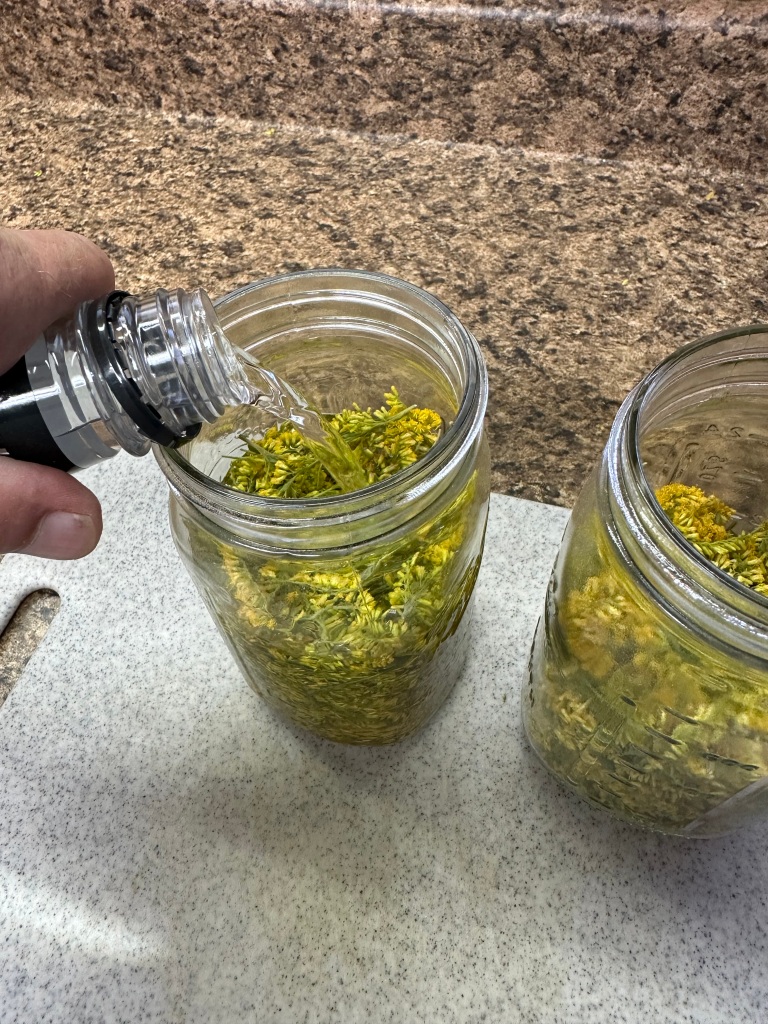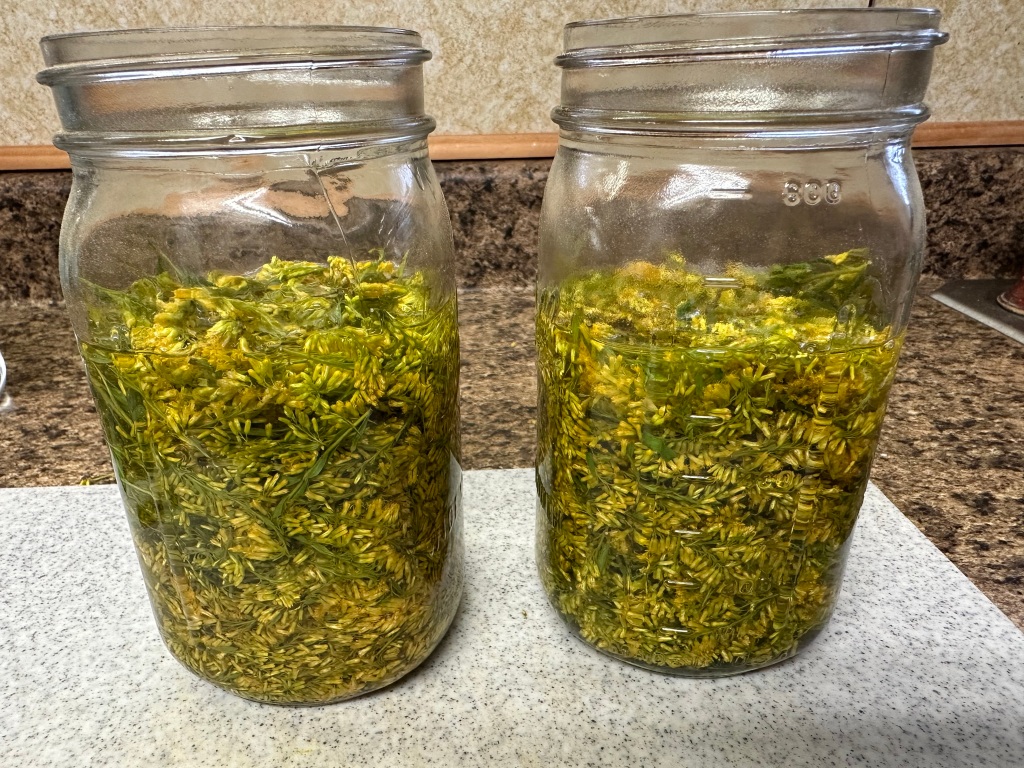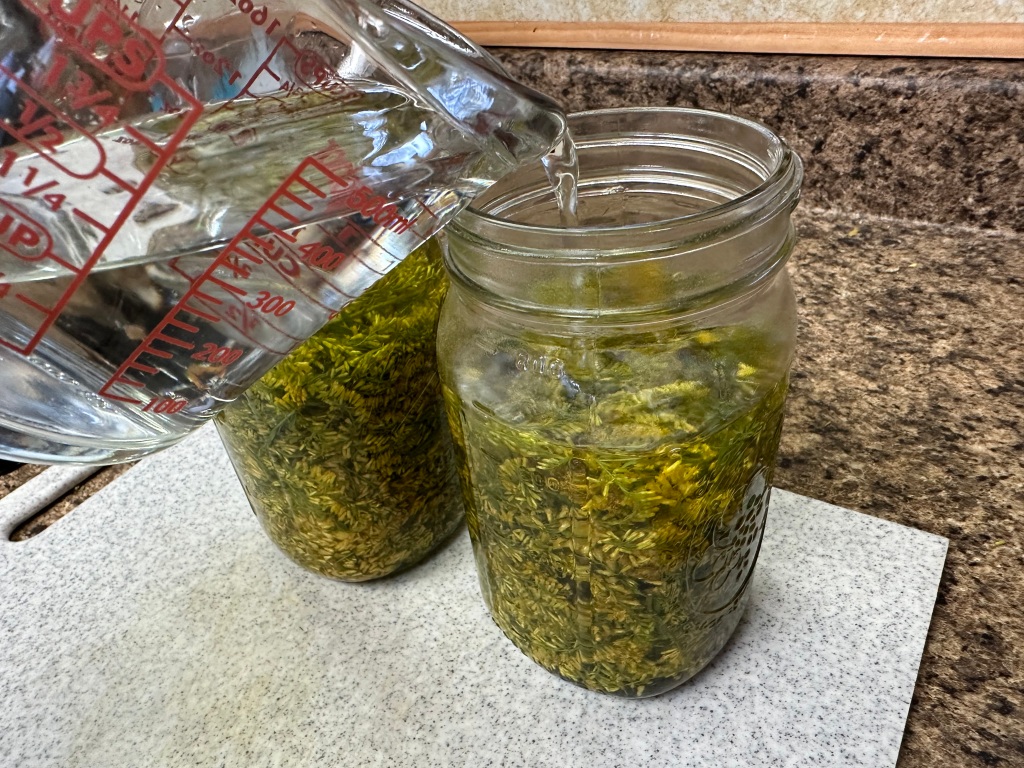The end of last year we started a series by our friend and Doing the Stuff Network member Kat Yorba called Go-to Herbal Medicine Kit. With herbs and weeds growing crazy this time of the year, I thought it was time to pick it back up and keep learning about herbal remedies. Here’s part 4…
For a refresher, you can check out the previous posts below:

by Kat Yorba
Today we begin a 3 part look at Bites, Stings and Splinters. In the process we will look at many different herbs, essential oils and clays as well as make various herbal preparations.
Ready to get started?? Here we go:
Bites, Stings & Splinters…Oh MY!
OUCH!

One yellow jacket did this damage!
Summer brings many pleasures…sunshine, long days, playing in the water and…MOSQUITOES!
If those pesky mosquitoes keep you from enjoying your summer fun…fear not, mother nature is here! Minor bites from mosquitoes and other insects respond very quickly to a wonderfully easy to prepare herbal oil.
Insect Bite Oil Recipe – Printable!
Click HERE to print
One more recipe for you…courtesy of Frugally Sustainable!
(This is a more advanced recipe for later use)
Itch Relief Stick
Itch Relief Stick
Ingredients
-1 ounce (approx. 2 tablespoons) olive oil infused with calendula flowers, chickweed, nettle leaf, lemon balm leaf, plantain leaf, and goldenseal root
-1 ounce (approx. 2 tablespoons) Shea butter
-1 ounce (approx. 2 tablespoons) cocoa butter
-1 ounce (approx 2 tablespoons) beeswax
-1 teaspoon Neem oil
-2 teaspoons essential oil blend (You can use a blend of clove, lavender, rosemary, peppermint, tea tree and/or ginger)
Method
1. Infuse your oil with the herbs.
2. In a double boiler, or small pot, over very low heat slowly melt the olive oil, butters, beeswax, and neem oil.
3. Once melted remove from heat and allow to cool slightly before adding the essential oils.
4. Pour mixture into a clean roll-up or lip balm tube and allow it to cool on the counter overnight.
Notes
-This Homemade Itch Relief Stick contains herbs that have been well-known for their strong antihistamine, analgesic, and antibacterial properties. Not only will this stick stop the itch, but it may reduce the risk for infection!
-The butters act as skin protectors to provide instant relief of itchiness and pain due to all sorts of insect bites and stings.
-This recipe makes quite a bit — approximately 4 ounces of product — so go in with a friend or two and share resources!
Let’s talk about some herbs and essential oils for a bit, to prepare us for our next posts recipe.
Echinacea
Echinacea is native to North America, with most of the research on this King of Immunity Herbs being done in Germany…and it’s early use gleaned from native healers. Now it is the herb of choice being one of the handful of medicinal herbs that are well-known by the general public.
There are several species of Echinacea that can be used: E. angustifolia, E. purpurea, and E. pallida. All 3 species can be used and are interchangeable, however E. angustifolia lasts longer after its been dried.
We mainly harvest the root, but it’s common to see medicine made from the aerial portions of the plant as well. To harvest the roots and obtain the most medicinal qualities, harvest them in the fall after the plants have been growing for at least 2-3 years. The aerial portions can be harvested in the summer not matter the age of the plant. Remember when harvesting the aerial portions to leave enough of the
Plant for it to gather enough energy for next years growth.
Without a doubt, Echinacea is one of the most popular herbs today. With over 300 echinacea products being sold worldwide. Nearly 400 studies have shown that Echinacea can be used to improve the immune system in numerous ways. These include increasing activity of three of the immune systems workhorses-T-cells, Interferon and Natural Killer Cells. Echinacea also destroys many types of viruses and bacteria. Echinacea even makes cells stronger and more resistant to invasion.
Also known as
Echinacea purpurea, Echinacea pallida, Echinacea angustifolia, Coneflower, Snakeroot, Purple Coneflower, and Blacksamson.
Constituents
The complex sugars of the herb are its immune stimulants. Polysaccharides and Echinaceoside.
Parts Used
The root, leaves, stems and flowers, of Echinacea purpurea, Echinacea angustifolia, or Echinacea pallida.
Typical Preparations
The above-ground parts of the plant are used to make fresh juice, infusions (warm-water teas), and tinctures. The roots are used in either cut or powdered form for capsules, fluid extracts, teas, and tinctures.
Precautions
Use with caution if you are allergic to ragweed.
*Courtesy of Mountain Rose Herbs
Lavender
Lavender was widely used in ancient Egypt for its fragrance, and it was also a favorite in the homes of Greeks and Romans. Even its name is derived from the Latin, lavare, meaning “to wash”, because it was used in scented baths.
In Arab medicine, Lavender was used as an expectorant and antispasmodic, while European folk medicine regarded it as essential for healing wounds and as a worm remedy for children.
This fragrant plant is also famous for its wonderful aroma, which is used much in the perfume industry. It is also widely used medicinally and is a staple of aromatherapy to promote relaxation.
Lavender has been used for centuries as a tonic to ease conditions of the nervous system. It is a relaxant that calms nerves, relieves fatigue, depression, migraine and tension headaches, nervous exhaustion, irritability and excitement.
Also known as
Lavandula (spp- intermedia, pendunculata, officinalis and angustifolia) English lavender, Broad-leaf Lavender, Grande Lavander and True Lavender
Constituents
Essential oil containing borneol, camphor, geraniol, and linalool, also coumarins, caryophyllene, tannins, and other antioxidant compounds.
Parts Used
Flowers.
Typical Preparations
Teas, tinctures, and added to baked goods. Cosmetically it has a multitude of uses and can be included in ointments for pain and burn relief.
*Courtesy of Mountain Rose Herbs
Bentonite Clay
What is it? Bentonite, also referred to as Montmorillonite, is one of the most effective and powerful healing clays. Bentonite can be used externally as a clay poultice, mud pack or in the bath and, in skin care recipes. A good quality Bentonite should be a grey/cream color and anything bordering “pure white” is suspect. It has a very fine, velveteen feel and is odorless and non-staining. The type of bentonite offered by Mountain Rose herbs is a Sodium Bentonite.
How does it work? Bentonite is very unusual in the fact that once it becomes hydrated, the electrical and molecular components of the clay rapidly change and produce an “electrical charge”. To state it another way… “Bentonite is a swelling clay. When it becomes mixed with water it rapidly swells open like a highly porous sponge.
Where does it come from? Bentonite clay is sedimentary clay composed of weathered and aged volcanic ash. The largest and most active deposits come from Wyoming and Montana. (Mountain Rose Herbs stocks a Wyoming variety).
How is it manufactured? Bentonite is usually quarry mined from deposits that can range anywhere from 100 feet to several thousand feet. This depends on the health and vitality of the land it is processed from and how far a producer will go to find the right clay with the proper characteristics and consistency. From here it is mined from the earth and brought out into the sun to remove excess water and moisture and, to make it easier to work with. After the initial drying begins the final transformation. It gets processed (ground) with huge hydraulic crushers and it then goes through the final process of micronization, or “fine granulating”. This is usually done with the assistance of sophisticated and expensive granulators. Upon completion of this final process it gets inspected by a quality control team and is sent off for consumer use.
Recap: Today we learned a bit about Bites and Stings, how to make an Insect Bite Oil and another wonderful recipe by Frugally Sustainable for later use! We also learned about Echinacea, Lavender and Bentonite Clay. Information provided is of general nature, there is much…much more out there to learn!
Looking ahead: Next post we will be learning further about Bites and stings, learning what a Poultice is and how to make one, learning what a Tincture is and how to make one.
Reminder: Have on hand Echinacea root and Vodka/Everclear, Lavender Essential Oil, Bentonite Clay, containers for all your remedies.
Blessings to you and yours,
Kat
———————————————
About Kat Yorba: Hi, I’m Kat. I’m a wife, mother, friend, massage therapist, writer, gardener, and child of God. I LOVE coffee, chocolate, essential oils, good books, cats, motorcycles, guns, drag racing and living in the USA! Learning to be more self-reliant & self-sufficient in a semi-homemade, homesteading way! Connect with Kat on her blog, Simply Living Simply, Facebook, Twitter, Pinterest, and Google+.
Kat’s Printable Resources:
Herbal Medicine Kit-Bites, Stings, Splinters part 1
Link for Insect Bite Oil
Herbal Medicine Kit-Bites, Stings, Splinters part 2
Poultice Link
Link to Echinacea Tincture
Herbal Medicine Kit-Bites, Stings, Splinters part 3
Link to Ant Bite/Nettle Remedy
Link to Yellowdock Tincture
Link to Yellowdock Syrup
P.S. – You can also keep up with the Stuff we’re Doing on Twitter, Pinterest, Google +, and our Facebook page… and over at the Doing the Stuff Network on Pinterest, Google +, and Facebook.
P.P.S – If you find value in our blog, Dirt Road Girl and I would appreciate your vote on Top Prepper Sites! You can vote daily by clicking here or on the image below. Check out all the other value-adding sites while you’re there…

Thanks for Sharing the Stuff!
Copyright: Content on this site (unless the work of a third-party) may be shared freely in digital form, in part or whole, for non-commercial use with a link back to this site crediting the author. All links in articles must remain intact as originally posted in order to be republished. If you are interested a third-party article, please contact the author directly for republishing information.










































